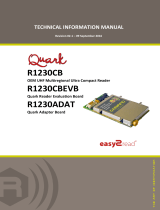
Intel
®
Quark SoC X1000 Core
October 2013 Developer’s Manual
Order Number: 329679-001US 15
Contents—Intel
®
Quark Core
28 Descriptor Types Used for Control Transfer..................................................................86
29 Use of CR3 with PAE Paging.......................................................................................93
30 Format of a PAE Page-Directory-Pointer-Table Entry (PDPTE).........................................94
31 Format of a PAE Page-Directory Entry that Maps a 2-MByte Page....................................96
32 Format of a PAE Page-Directory Entry that References a Page Table................................97
33 Format of a PAE Page-Table Entry that Maps a 4-KByte Page .........................................97
34 Page Level Protection Attributes............................................................................... 103
35 Write-Back Enhanced Intel
®
Quark SoC X1000 Core WB/WT# Initialization.................... 115
36 Cache Operating Modes .......................................................................................... 116
37 Write-Back Enhanced Intel
®
Quark SoC X1000 Core Write-Back Cache Operating
Modes .................................................................................................................. 117
38 Encoding of the Special Cycles for Write-Back Cache................................................... 119
39 Cache State Transitions for Write-Back Enhanced Intel
®
Quark SoC X1000
Core-Initiated Unlocked Read Cycles......................................................................... 124
40 Cache State Transitions for Write-Back Enhanced Intel
®
Quark SoC X1000
Core-Initiated Write Cycles...................................................................................... 125
41 Cache State Transitions During Snoop Cycles............................................................. 125
42 SMRAM State Save Map.......................................................................................... 132
43 SMM Initial Processor Core Register Settings ............................................................. 136
44 Bit Values for SMM Revision Identifier....................................................................... 138
45 Bit Values for Auto HALT Restart.............................................................................. 139
46 I/O Instruction Restart Value................................................................................... 140
47 Cache Flushing (Non-Overlaid SMRAM) ..................................................................... 144
48 Cache Flushing (Overlaid SMRAM)............................................................................ 145
49 ADS# Initiated Bus Cycle Definitions ........................................................................ 152
50 Differences between CACHE# and PCD ..................................................................... 161
51 CACHE# vs. Other Intel
®
Quark Core Signals ............................................................ 162
52 HITM# vs. Other Intel
®
Quark Core Signals............................................................... 163
53 INV vs. Other Intel
®
Quark Core Signals................................................................... 163
54 WB/WT# vs. Other Intel
®
Quark Core Signals............................................................ 164
55 Register Values after Reset...................................................................................... 170
56 Floating-Point Values after Reset.............................................................................. 170
57 FERR# Pin State after Reset and before FP Instructions............................................... 174
58 Pin State during Stop Grant Bus State ...................................................................... 175
59 Write-Back Enhanced Intel
®
Quark SoC X1000 Core Pin States during Stop Grant Bus
Cycle.................................................................................................................... 176
60 Byte Enables and Associated Data and Operand Bytes................................................. 184
61 Generating A[31:0] from BE[3:0]# and A[31:A2]....................................................... 185
62 Next Byte Enable Values for BSx# Cycles.................................................................. 187
63 Data Pins Read with Different Bus Sizes .................................................................... 187
64 Generating A1, BHE# and BLE# for Addressing 16-Bit Devices..................................... 189
65 Generating A0, A1 and BHE# from the Intel
®
Quark SoC X1000 Core Byte Enables ........ 191
66 Transfer Bus Cycles for Bytes, Words and Dwords ...................................................... 192
67 Burst Order (Both Read and Write Bursts) ................................................................. 206
68 Special Bus Cycle Encoding ..................................................................................... 221
69 Bus State Description ............................................................................................. 224
70 Snoop Cycles under AHOLD, BOFF#, or HOLD............................................................ 228
71 Various Scenarios of a Snoop Write-Back Cycle Colliding with an On-Going Cache Fill or
Replacement Cycle................................................................................................. 230
72 Debug Registers .................................................................................................... 247
73 LENi Encoding........................................................................................................ 248
74 RW Encoding......................................................................................................... 248
75 Fields within Intel
®
Quark Core Instructions .............................................................. 254
76 Encoding of Operand Length (w) Field....................................................................... 255
77 Encoding of reg Field when the (w) Field is Not Present in Instruction............................ 255






















